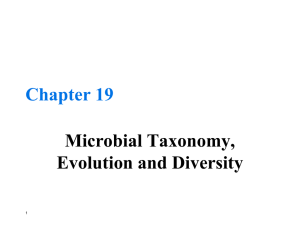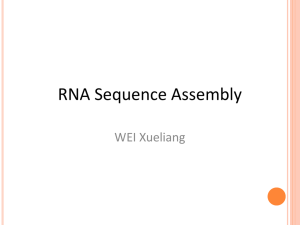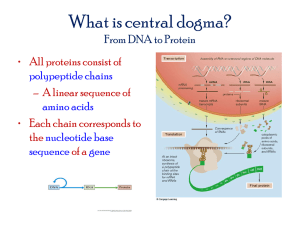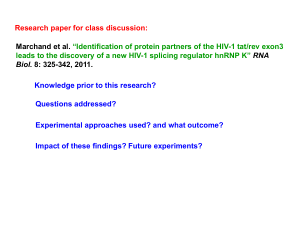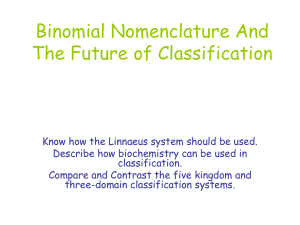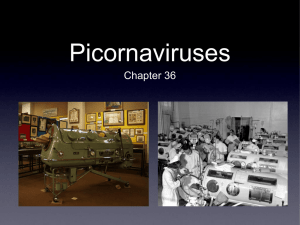THE COOLEST POWER POINT EVER =)
advertisement
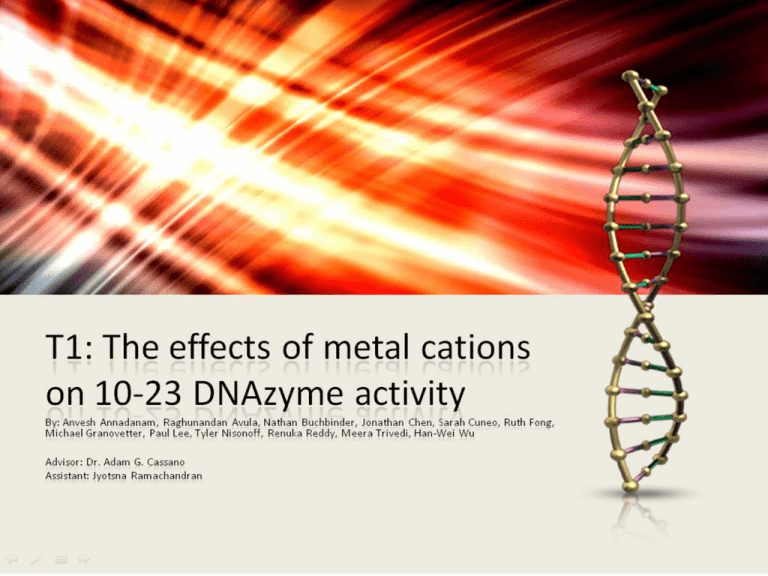
T1: The effects of metal cations on 10-23 DNAzyme activity By: Anvesh Annadanam, Raghunandan Avula, Nathan Buchbinder, Jonathan Chen, Sarah Cuneo, Ruth Fong, Michael Granovetter, Paul Lee, Tyler Nisonoff, Renuka Reddy, Meera Trivedi, Han-Wei Wu Advisor: Dr. Adam G. Cassano Assistant: Jyotsna Ramachandran The Big Three DNA – Deoxyribonucleic Acid RNA – Ribonucleic Acid Proteins http://www.scq.ubc.ca/a-monks-flourishinggarden-the-basics-of-molecular-biology-explained/ http://iascnsh.org/CNSH%C4%90%E1%BB%99ngV%E1%BA %ADt/CNSHTrongTh%C3%BAY/tabid/60/BlogDat e/2009-02-28/DateType/month/Default.aspx http://www.mpsciences.com/index-2.html Which Came First? DNA Proteins RNA http://library.thinkquest.org/C0122429/intro/genetics.htm Ribozymes RNA is capable of enzyme activities in certain cases Functions are vital to life Shows a mixture of functions between DNA and enzymes (proteins) Newest discovery: DNAzyme DNAzymes Discovered in 1997 DNA with enzymatic functions Capable of site-specific cleavage of RNA molecules 10-23 DNAzyme Cleaves target RNA in a sequence specific manner Requirement: Metal cations as cofactors 10-23 DNAzyme: Previous Research Mg2+ cation works Monovalent cations not as efficient Other salts not nearly as effective Properties of cofactors in reaction still not fully understood Role of cofactors in the reaction Medical Applications RNA retroviruses Treatment can be potentially damaging DNAzymes show promise http://www.deanza.fhda.edu/workforceed/images/06%20medical%20lab.jpg http://www.mydogella.com/steth.jpg Purpose of Our Project Functional mechanism of the 10-23 DNAzyme and its cofactors Ligand exchange Ionic Radius Charge of the Mg2+ http://img.search.com/thumb/f/fd/CoA6Cl3.png/200px-CoA6Cl3.png Santoro SF and Joyce GW 1998 Questions to be Answered Which factor is most important? Ligand exchange Molecular size Which concentration works the best? http://cvbinasejahtera.blogspot.com/2009/09/bahan-bahankimia-industri.html http://www.made-in-china.com/showroom/starchemicalssellers/productdetailAMjmsnZgaGpz/China-Strontium-Carbonate.html Reactions Total Volume 10 µL 10-23 DNAzyme 1 µL RNA Substrate 1 µL EPPS Buffer 1 µL EDTA (ethylene diamine tetra-acetic acid) 1 µL Monovalent Salts (NaCl) 1 µL Cobalt Hexamine/ Strontium Chloride + H20 = 5 µL 15% Polyacrylamide PAGE Gel with Urea http://biotech.matcmadison.edu/resources/proteins/labManual/images/220_04_039.gif Migration of DNA - + p. 2-12 Controls and Standards Initial Cobalt and Strontium Reactions Reactions ran for one hour Trial one gel ran for 45 min Trial two gel ran for one hour SYBR green staining time increase Reactions at 37 oC Cobalt Hexamine: Initial Trials Strontium: Initial Trials Experimental Improvements 1. Reaction time increased 2. Gel Electrophoresis running time increased 3. SYBR-Green staining time increased Strontium: Trial 3 Strontium Trial 3: Percent of RNA Product After Electrophoresis 90 80 70 % Product 60 50 40 30 20 10 0 10mM 50mM 100mM 150mM Reaction Solution 250mM Positive Control Cobalt Hexamine: Trial 3 Cobalt Hexamine Trial 3: Percent of RNA Product after Electrophoresis 90 80 70 % Product 60 50 40 30 20 10 0 RNA Product Negative Positive Substrate Standard Control Control 130mm 100mm Reaction Solution 75mm 50mm 25mm Conclusions Strontium properties Cobalt Hexamine properties Ligand exchange is more important than size Concentration effects Acknowledgements Dr. Adam Cassano (Break a leg) Dr. David Miyamoto Dr. Paul Quinn John and Laura Overdeck Bayer HealthCare Bristol-Myers Squibb Jewish Communal Fund The Ena Zucchi Trust Johnson & Johnson Roche Novartis The Crimmins Family Charitable Foundation Independent College Fund of New Jersey The Edward W. and Stella C. Van Houten Memorial Fund Drew University Questions?



